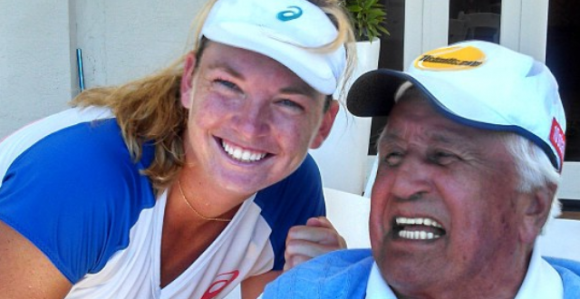PANCHO SEGURA WOULD HAVE WON A DOZEN FRENCH OPENS , OK @ LEAST A HALF DOZEN
A cement player who goes to clay, composition or grass for the first time is confronted with the problem of not being able to run well. His feet seem to move in place because he is not getting any traction. Thirty years ago, the problem of playing on clay was much more acute. The courts were more slippery then because there was a layer of dust-like material on the top. Bitsy Grant, one of the all-time great clay court players, used to bet that he could slide from the baseline to the service line and stop on a dime.
He never lost the money, although he, too, was somewhat “lost” on wet grass. The following hints will help the newcomer adjust to a surface more quickly.
Most professionals teach their pupils to hit groundstrokes with their side to the net. As they hit the ball, the front leg is supposed to move into the shot, i.e., toward the net. This always holds true when there is plenty of time to get to a ball and the footing is sure. On clay, composition or grass, the player moving toward a ball runs several steps less, then slides into the shot. This saves energy for the long matches and means that the player does not have to be in perfect position to hit a ball since he has to slide at the last minute.
The slide when running to the forehand side finds the player hitting with an open stance. If the player is righthanded, he plants his left foot and slides his right foot sideways to meet the ball. If he were to slide his left foot, he would be too twisted in relation to the net to effect a good shoulder turn and powerful shot. Normally the foot slides two or three feet. When our right-handed friend changes directions and goes forward, it is his left foot that slides; the shot usually looks like a classical, hard surface forehand, with the left leg a little more extended than usual. This spreading of the feet when moving forward is very good since the player hits the ball more in front of his body and, consequently, gets more power. The open stance usually results in a more defensive shot than the closed stance unless there is a good weight shift at the last minute since the weight is not being moved from back to front foot unless the shoulder comes through well. Therefore the open stance forehand is seen more frequently on clay or composition courts than on grass since on the latter surface most players are always moving into net (as the player moves to net behind a ball, he generally turns his left shoulder in and the stance is seldom completely open).
There are few if any open stance backhands that are satisfactory. In other words, a righthanded player cannot slide his left foot to meet a ball on his backhand side. He is then unable to turn his right shoulder because he is facing the net and it has already been turned. When he moves forward, his right foot also slides because he must keep his right shoulder toward the net until he makes contact with the ball and turns it.
Because footing is sure on cement and the surface is so hard, players changing to clay or grass are afraid to slide or fall. But sliding on clay or grass is necessary, and falling properly is seldom dangerous on grass. A last-minute, flat-out lunge often wins a point. However, such acrobatic action should not be overdone unless the player would prefer to be a circus performer rather than a tennis star.
Earlier it was mentioned that the great slider, Bitsy Grant, could not cope with wet grass. He would wear spikes whenever he could, but that is not allowed in this age when grass courts are more important than the necks of those who play on them. The best advice for playing on wet grass is “stay low, keep your legs apart and knees bent so that you run as in a crouch, and dig in with your toes.” If you try to slide and stop on wet grass, you are likely to end up looking like a puddle rather than a tennis player.
The invention of rib-soled tennis shoes since the war has made sliding easier and more controllable. These shoes make it possible to stop quickly and at will on all but the slipperiest of surfaces.
Topics: French Open, Pancho Segura, Tennis, Tennis News


10sBalls Top Stories
- Reasons Behind the Increase in Sex Shops
- Reasons Behind the Increase in Sex Shops
- Reasons Behind the Increase in Sex Shops
- Casibom: Yaşayan Casinolar ve Bahisler Lider Platform
- Sea Star Casino: Play Games Without Registering Online
- JETZT DEN SWEET BONANZA SLOT GRATIS DREHEN
- Азартные игры с Мостбет Казино – испытайте удачу
- Çevrimiçi en iyi yuvalar: Hizmetinizde Karavan Bet Casino
- Top No Deposit Free Spins Offer for Canadians – December 2024
- Abe Bet Casino: Ücretsiz dönüşlerle heyecan hissedin
- Ünlü slotlar çevrimiçi kumarhanelerde başarı bet giriş ücretli formatta
- BasariBet Casino Giriş – En Güzel Canlı Casino Oyunlarına Katılın
- Игра на деньги в казино 1вин казино: безопасность
- De parking de credits sans oublier les Diction Casino Archive sauf que Perception
- Играть в хитовые слоты в надежных клубах azino777





 PANCHO SEGURA WOULD HAVE WON A DOZEN FRENCH OPENS , OK @ LEAST A HALF DOZEN |
PANCHO SEGURA WOULD HAVE WON A DOZEN FRENCH OPENS , OK @ LEAST A HALF DOZEN | 
PANCHO SEGURA WOULD HAVE WON A DOZEN FRENCH OPENS , OK @ LEAST A HALF DOZEN – http://t.co/krvlVekpEv #tennis #FrenchOpen
PANCHO SEGURA WOULD HAVE WON A DOZEN FRENCH OPENS , OK @ LEAST A HALF DOZEN
http://t.co/39Lk8EGBy9